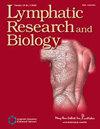Relation Between Characteristics of Indocyanine Green Lymphography and Development of Breast Cancer-Related Lymphedema.
IF 1.9
4区 医学
Q3 MEDICINE, RESEARCH & EXPERIMENTAL
引用次数: 0
Abstract
Background: Breast cancer-related lymphedema (BCRL) is a disabling and frequently occurring condition after treatment for breast cancer. Studying lymph anatomy by means of indocyanine green (ICG) lymphography is a promising tool to help better understand BCRL. The aim of this study is to investigate the relation between ICG lymphography characteristics and the risk of developing BCRL. Methods and Results: Patients scheduled for breast surgery with either unilateral axillary lymph node dissection or sentinel lymph node biopsy between November 2017 and May 2019 were included. Patients were assessed at baseline and up to 36 months postsurgery. BCRL was defined as an increase of ≥5% relative arm volume difference compared with the presurgical difference. In total, 128 patients were included. During 36 months of follow-up, 45 patients (35.2%) developed BCRL. The number of lymph vessels before surgery was not a statistically significant risk factor for developing BCRL (p = 0.8485). However, an increase in the number of lymph vessels compared with baseline was a significant protective factor for developing BCRL (odds ratio = 0.8). An increase of one lymph vessel corresponds to a 19% relative risk reduction of developing BCRL. The presence of lymph nodes at baseline and the change in the presence of lymph nodes compared with baseline were no predictors for the development of BCRL (p = 0.0986 and p = 0.8910, respectively). Conclusions: An increase in the number of lymph vessels visualized by ICG lymphography compared with baseline is a protective factor for developing BCRL. Therapies with the ability to increase the number of lymph vessels can thus possibly decrease the risk of developing BCRL.吲哚菁绿淋巴造影的特征与乳腺癌相关淋巴水肿发展之间的关系
背景:乳腺癌相关淋巴水肿(BCRL)是乳腺癌治疗后经常出现的一种致残性症状。通过吲哚菁绿(ICG)淋巴造影术研究淋巴解剖是一种很有前途的工具,有助于更好地了解乳腺癌相关淋巴水肿。本研究旨在探讨 ICG 淋巴造影特征与 BCRL 发病风险之间的关系。方法和结果:纳入2017年11月至2019年5月期间计划进行单侧腋窝淋巴结清扫或前哨淋巴结活检的乳腺手术患者。患者在基线和术后 36 个月内接受评估。BCRL的定义是与手术前相比,相对手臂体积差异增加≥5%。共纳入了 128 名患者。在36个月的随访期间,45名患者(35.2%)出现了BCRL。手术前淋巴管的数量不是导致 BCRL 的具有统计学意义的风险因素(p = 0.8485)。然而,与基线相比,淋巴管数量的增加是罹患 BCRL 的重要保护因素(几率比 = 0.8)。淋巴管数量每增加一条,患 BCRL 的相对风险就会降低 19%。基线时淋巴结的存在情况以及淋巴结存在情况与基线相比的变化均不能预测 BCRL 的发生(分别为 p = 0.0986 和 p = 0.8910)。结论与基线相比,ICG淋巴造影所显示的淋巴管数量的增加是发生BCRL的一个保护因素。因此,能够增加淋巴管数量的疗法可能会降低罹患 BCRL 的风险。
本文章由计算机程序翻译,如有差异,请以英文原文为准。
求助全文
约1分钟内获得全文
求助全文
来源期刊

Lymphatic research and biology
Medicine-Cardiology and Cardiovascular Medicine
CiteScore
3.10
自引率
7.10%
发文量
85
审稿时长
>12 weeks
期刊介绍:
Lymphatic Research and Biology delivers the most current peer-reviewed advances and developments in lymphatic biology and pathology from the world’s leading biomedical investigators. The Journal provides original research from a broad range of investigative disciplines, including genetics, biochemistry and biophysics, cellular and molecular biology, physiology and pharmacology, anatomy, developmental biology, and pathology.
Lymphatic Research and Biology coverage includes:
-Vasculogenesis and angiogenesis
-Genetics of lymphatic disorders
-Human lymphatic disease, including lymphatic insufficiency and associated vascular anomalies
-Physiology of intestinal fluid and protein balance
-Immunosurveillance and immune cell trafficking
-Tumor biology and metastasis
-Pharmacology
-Lymphatic imaging
-Endothelial and smooth muscle cell biology
-Inflammation, infection, and autoimmune disease
 求助内容:
求助内容: 应助结果提醒方式:
应助结果提醒方式:


